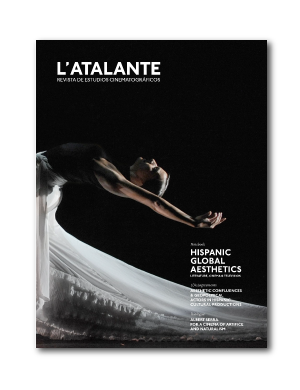A Defense of Impure Cinema: the Function of the “Other woman” in 'Rebecca' and 'Jane Eyre'
Published 2018-07-01
Keywords
- Rebeca,
- Jane Eyre,
- adaptaciones cinematográficas,
- teoría feminista del cine,
- psicoanálisis
- la Otra mujer. ...More
How to Cite
Copyright (c) 2018 L'Atalante. Journal of film studies

This work is licensed under a Creative Commons Attribution-NonCommercial-NoDerivatives 4.0 International License.
Abstract
In his article “Pour un cinéma impure”, André Bazin offers a passionate defence of film adaptations of theatrical and literary works. It is our aim to build on Bazin’s defence of an “impure cinema” through the films Rebecca (A. Hitchcock, 1940) and Jane Eyre (C. Fukunaga, 2011). By presenting an interpretative analysis of these two film adaptations, we raise two points. First of all, that the discourses of both films, by highlighting the Gothic interweaving of violence and sexual passion, come into contradiction with the “civilised” sexual morality characteristic of capitalism. And secondly, that in placing the ghostly figure of the Other Woman at the centre of the narrative trajectory of their heroines, both films are privileged artistic spaces for investigating the cultural function played by this classical female fantasy.
Downloads
References
Barthes, R. (1991). Lección inaugural de la cátedra de semiología literaria del Collège de France. En R. Barthes, <em>El placer del texto y Lección inaugural de la cátedra de semiología literaria del Collège de France</em> (pp. 111-150). Madrid: Siglo XXI.<br>
Brontë, C. (1999). <em>Jane Eyre</em>. Barcelona: Alba.<br>
Cook P., Johnston, C. (1988). The Place of Woman in the Cinema of Raoul Walsh. En C. Penley (ed.), <em>Feminism and Film Theory</em> (pp. 25-35). Londres: Routledge, BFI.<br>
Copjec, J. (1994). Vampires, Breast-Feeding, and Anxiety. En J. Copjec, <em>Read My Desire. Lacan against the Historicists</em> (pp. 117-139). Londres: The MIT Press.<br>
Cowie, E. (1990). Fantasia. En P. Adams y E. Cowie (eds.) (1990). <em>The Woman in Question</em> (pp. 149-196). Londres: Verso.<br>
De Lauretis, T. (1984). <em>Alice Doesn’t. Feminism, Semiotics, Cinema</em>. Londres: MacMillan.<br>
Doane, M. A. (1981). <em>Caught</em> and <em>Rebecca</em>: The Inscription of Femininity as Absence. <em>Enclitic</em>, <em>5</em>(2), 75-89.<br>
— (1987). <em>The desire to desire. The woman's film of the 1940s</em>. Londres: MacMillan.<br>
Du Maurier, D. (1971). <em>Rebeca</em>. Barcelona: Peguin Random House Grupo. <br>
Freud, S. (1972). <em>Duelo y melancolía</em>. En S. Freud, <em>Obras Completas,</em> vol. 6 (pp. 2091-2100). Madrid: Biblioteca Nueva. <br>
— (1987). La moral sexual ‘cultural’ y la nerviosidad moderna. En S. Freud, <em>Obras Completas,</em> vol. 4 (pp. 1249-1261). Madrid: Biblioteca Nueva. <br>
Gilbert, S. M., Gubar, S. (1979). <em>La loca del desván. La escritora y la imaginación literaria del siglo XIX</em>. Madrid: Cátedra.<br>
Johnston, C. (1976). Women’s Cinema as Counter-cinema. En B. Nichols (ed.), <em>Movies and Methods: An Anthology, </em>vol. 1(pp. 208-217). Berkeley: University of California Press.<br>
Kuhn, A. (1991). <em>Cine de mujeres. Feminismo y cine</em>. Madrid: Cátedra.<br>
Lacan, J. (2004). <em>El seminario de Jacques Lacan. Libro 2. El Yo en la teoría de Freud y en la técnica psicoanalítica. </em>Barcelona: Paidós.<br>
— (2006). <em>El seminario de Jacques Lacan. Libro 3. Las psicosis</em>. Barcelona: Paidós.<br>
— (2011). <em>El seminario de Jacques Lacan. Libro 16. De un Otro al otro.</em> Barcelona: Paidós.<br>
— (2013). El seminario sobre “La carta robada”. En J. Lacan, <em>Escritos 1</em> (pp. 23-69). Madrid: Siglo XXI.<br>
Light, A. (1984). ‘Returning to Manderley’ – Romance Fiction, Female Sexuality and Class. <em>Feminist Review, </em>16, 7-24.<br>
Mira, V. (2018). La histeria o el atolladero de la mujer. En G. Fernández de Loaysa (coord.), <em>Vicente Mira. Hojas volantes</em>. País Vasco: Pliegues (en prensa).<br>
Mitchell, J. (1982). <em>Psicoanálisis y feminismo. Freud, Reich, Laing y las mujeres</em>. Barcelona: Anagrama. <br>
Modleski, T. (1987). Time and Desire in the Woman's Film. En C. Gledhill (ed.), <em>Home is Where the Heart is. Studies in Melodrama and the Woman's Film</em> (pp. 326-338). Londres: BFI. <br>
— (1988). <em>The Women Who Knew Too Much. Hitchcock and Feminist Theory</em>. Londres: Methuen.<br>
Mulvey, L. (1992). Visual Pleasure and Narrative Cinema. En M. Merck (ed.), <em>The Sexual Subject. A Screen Reader in Sexuality</em> (pp. 22-34). Londres: Routledge.<br>
— (1996). Pandora’s Box: Topographies of Curiosity. En L. Mulvey, <em>Fetishism and Curiosity</em>. Londres: BFI.<br>
Pérez Bowie, J. A. (2010). <em>Reescrituras fílmicas: nuevos territorios de la adaptación</em>. Salamanca: Ediciones Universidad de Salamanca.<br>
Pollock, G. (1992). What’s Wrong with ‘Images of Women’? En M. Merck (ed.), <em>The Sexual Subject. A Screen Reader in Sexuality</em> (pp. 135-145). Londres: Routledge. <br>
Propp, V. (1998). <em>Morfología del cuento</em>. Madrid: Akal.<br>
Russ, J. (1973). Somebody’s Trying to Kill Me and I Think It’s My Husband: The Modern Gothic. <em>Journal of Popular Culture, 6</em>(4), 666-691.<br>
Spoto, D. (2001). <em>Alfred Hitchcock. La cara oculta del genio</em>. Madrid: T&B Editores. <br>
Weber, M. (2002). <em>La ética protestante y el «espíritu» del capitalismo</em>. Madrid: Alianza Editorial.<br>
Woolf, V. (1992). Professions for Women. En V. Woolf, <em>Killing the Angel in the House</em>. Nueva York: Penguin Group.</p>

